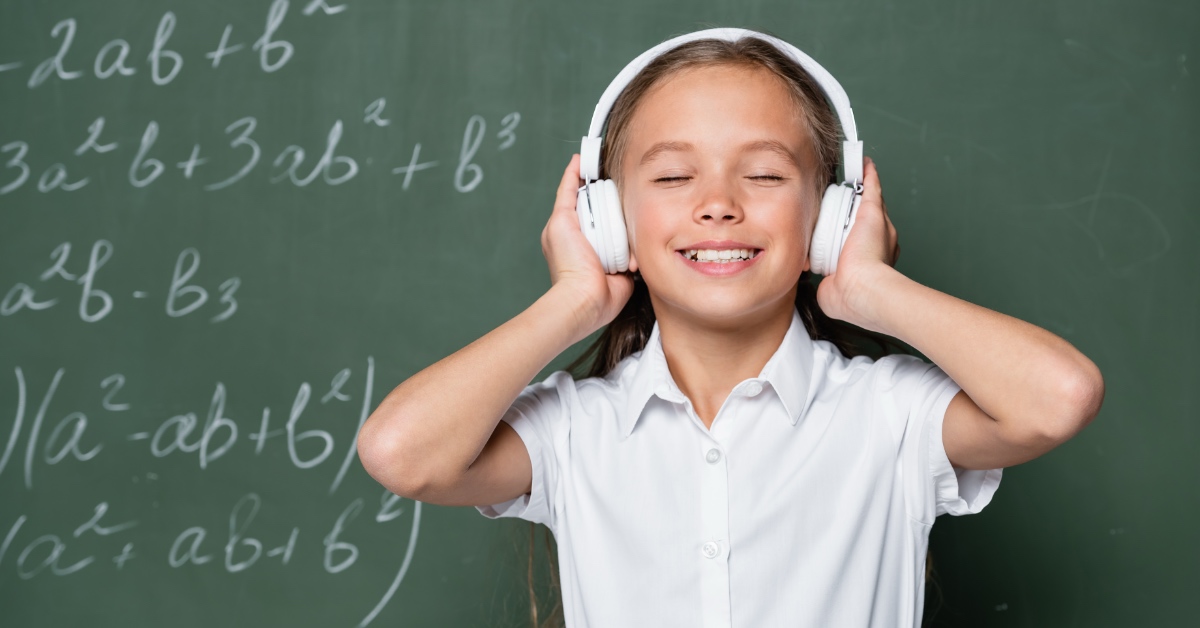
At the heart of a child’s education are the rich, relevant, and rewarding experiences that aid their understanding of the world around them. To fully reach students, their school curriculum should brim with opportunities to engage students’ entire brains with interactive, real-world lessons.
Whether children are taught at home or attend a traditional school, parental involvement greatly impacts student learning. This is especially true for parents whose children have visual or auditory limitations. In these cases, how a child learns has a direct impact on their learning goals and success. Parents can help by involving their children in multisensory activities whenever possible.
Learning becomes a feast for all five senses when engaging a student’s whole brain. A multisensory learning strategy takes full advantage of how children learn and helps parents and teachers better educate their students in everything from phonemic awareness to letter recognition to mathematics. Especially in their early years, children’s school experiences are often chaotic and unintegrated.
Recent research shows that a multisensory approach to education can help improve learning outcomes and academic performance regardless of socioeconomic status. Multisensory integration can help struggling readers, kids with visual or auditory problems, or children who lack educational resources outside the classroom.
What is Multisensory Learning?
Multisensory learning is any form of knowledge retention that involves multiple senses at once.
Since most standard curricula include reading text and listening to instructions, most lessons can be considered multisensory in nature. Typically, however, the term “multisensory learning” is used to describe learning that utilizes senses beyond sight and sound and involves more than one sense at a time, such as smelling and tasting.
At a young age, most people are taught the five senses: sound, sight, smell, taste, and touch. However, modern scientists actually identify other, more subtle senses, as well. Those in the cognitive sciences classify them as follows:
- Proprioception: the perception of body position and movement
- Thermoception: the perception of heat
- Equilibrioception: the perception of balance
- Nociception: the perception of pain
Just like the five senses, incorporating these submodal senses into lessons requires creativity and appropriate application. Thermoception may work great for chemistry class, but probably not for civics.
Traditional education tends to focus heavily on sight and sound because those are the two primary ways people communicate. While these faculties are important, not every lesson must depend on them. Shakespeare’s works may not appear to offer much in the way of smell, taste, or touch, but with a little creativity, other senses can be involved. For example, cooking or sharing foods people ate in ancient Britain just before the Roman conquest (the settings for King Lear, Cymbeline, and Macbeth), such as wild game and vegetable dishes, can help round out the story and breathe life into the characters.
The preceding example demonstrates another reason parents and teachers rarely develop lesson plans that employ the use of all five senses: it can be challenging and time-consuming to brainstorm ideas and implement them.
Fortunately, it is possible to incorporate multisensory activities into many lessons, even for ideas as abstract as phonics instruction or mathematics.
The “Whole Brain Teaching” Controversy
As the submodal senses illustrate, the human brain has powerful multi-sensory capabilities. Every second of every day, our brains organize and synthesize an immense amount of data from our experiences. If you’ve ever had a “gut feeling” about something, your brain may have registered a subtle stimulus that exists just outside the parameters of our physical perceptions.
So why not try to make full use of our brains?
“Whole brain learning” is the converse of “whole brain teaching,” which is a relatively recent pedagogical phenomenon that focuses on triggering different parts of the brain to maximize its full potential. This teaching method is not without controversy, although it certainly has its adherents. Generally speaking, the approach utilizes gestures, repetition, and fast-paced activities in multisensory lessons. It focuses heavily on discipline and manners and employs both direct and collaborative instruction. Established in 1999, “whole brain teaching” hasn’t entirely caught on, perhaps because scholars have argued that any learning involves the “whole brain.”
Whether you agree or disagree with this pedagogy, one element is undeniable: the “whole brain” approach recognizes the importance and advantages of multisensory learning.
There are many different learning styles and teaching methods. Most parents and teachers adopt a specific approach and customize it to accommodate their students’ different learning styles.
While the “learning styles” concept is generally accepted among k-12 teachers and parents, the science is more complex and unsettled. Some research contends that learning styles are actually “learning preferences” and are therefore subjective, leading to what they call the “learning styles myth.” Their skepticism has weight; for example, one student might be highly visual in math class but auditory in another subject or setting.
Regardless of how you refer to a learning tendency–as a “preference” or a “style”–it’s hard to argue with academic success. If that involves customizing lessons to accommodate a student’s sensory predisposition, so be it. If a student learns one way in a certain setting and a different way in another, this only reinforces the importance of implementing multisensory learning as often as possible.
Advantages of Multisensory Learning
Multisensory learning offers several notable benefits for all types of students.
- Adaptability. Multisensory learning can work with a variety of pedagogies and learning styles.
- Engagement. It keeps students more focused and reduces their capacity for distraction.
- Recall. It improves memory and recall.
- Comprehension. It gives students a deeper understanding of the material, making it easier for them to retain information.
- Critical thinking. Engaging more senses helps students view material from a variety of perspectives, enhancing their ability to think critically and problem-solve.
- Language Development. Especially in younger children, multisensory learning helps associate words with physical objects, leading to better vocabulary retention and usage.
Multisensory instruction can help virtually any child, but it’s particularly beneficial for students who learn differently. Here are a few areas where multisensory teaching can be particularly beneficial:
- Autism. Students on the autism spectrum often have sensitivities or difficulties processing information in one or more modalities. Many cannot handle excessive light or sound, which creates problems for traditional instruction. A more multisensory teaching approach can help sidestep such issues.
- ADHD. Students with ADHD and other attention-related disorders can benefit greatly from multisensory instruction. Lessons that engage multiple senses help to tamp down outside distractions and make learning more exciting.
- Learning Disabilities. Whether it’s dyslexia or some other learning impairment, multisensory learning is critical. Students with dyslexia may have difficulty absorbing written text but have no trouble understanding the same text when it’s read to them.
- Young Children. Multisensory learning is also quite important for younger students who lack the focus necessary to concentrate on text or listen to long lectures. They often have a high energy surplus and would love nothing less than an excuse to stand up and run around. This makes kinesthetic activities particularly suitable for elementary school students.
Providing Multisensory Experiences at Home
Life is a multisensory experience. So is student learning. As a parent, the more you can connect the lessons from your children’s classrooms to the real-life experiences outside them, the more multi-sensory your students’ learning experiences will be. Parental involvement can be extremely helpful to this end, regardless of whether your family homeschools.
Here are a few ways parents can help augment classroom discussions and teach students through multisensory learning.
- Cooking. Preparing a meal combines mathematical measurement, strategy, multi-tasking, and reading with touch, taste, smell, and even … thermoception. When the meal is served, and everyone is eating, ask your kids if they can taste one of the added ingredients.
- Creating art. Although stories tend to engage the auditory or visual senses, they can provide many opportunities for sensory learning. If your students enjoy a particular scene from a book they are reading, ask them to turn it into artwork. A drawing or a painting gives you insight into how they see the story. Alternatively, you can ask them to act out a passage with costumes and scenery they create. This is a great way to turn reluctant readers into engaged readers.
- Outdoor exploration. Exploring the outdoors combines a host of disparate sensory experiences into a unified whole. Ask your students to identify leaves or birds, write about what they see in the woods, or mimic the sounds they heard during their outdoor adventure.
- Kinesthetic activities. Many kinesthetic techniques are useful for teaching writing and language skills. Young students learning the alphabet can strike poses in the shape of each letter or practice writing letters in different materials, such as Jello or sand.
It may seem that abstract subjects like math don’t fit neatly into the multisensory approach, but mathematical ideas start out as kinesthetic ideas. We learn to count using our fingers, and we learn about symmetry by manipulating shapes. Our Math-U-See curriculum is specifically designed to engage multiple senses through the hands-on use of colorful manipulatives.
Teaching Students Through Multisensory Learning: Why Parents Play an Important Role
Students learn in many different ways, and much of that learning occurs at home.
Regardless of how your students learn, your participation in your children’s education will not only help develop strong connections with them but also likely lead to academic success and higher grades.
A parent is a child’s first role model, and what you do will be copied or imitated by your kids. Giving them the support and resources they need to excel in school is important, but kids thrive on real-life interactions, and there is no substitute for parental involvement. Why not incorporate multisensory activities into the time you spend together?
Parents should be involved with multisensory learning whether they homeschool their kids or not. Every time a parent brings their children to work, helps them practice spelling, or provides an educational experience on a family trip, they impact their children’s education.
Multisensory learning taps into multiple senses, profoundly impacting children’s educational experiences and illustrating the vital role parents play in nurturing students’ learning environments.
Did you enjoy this article? Subscribe to our newsletter!




Leave a Reply